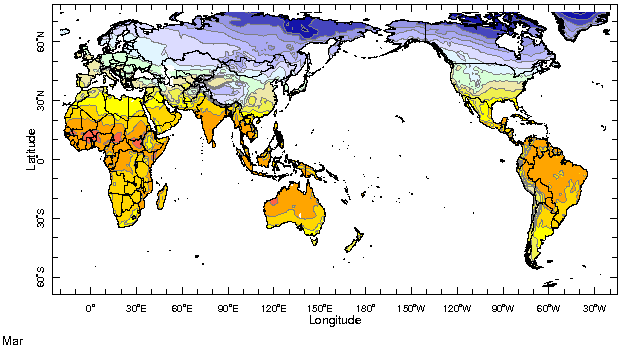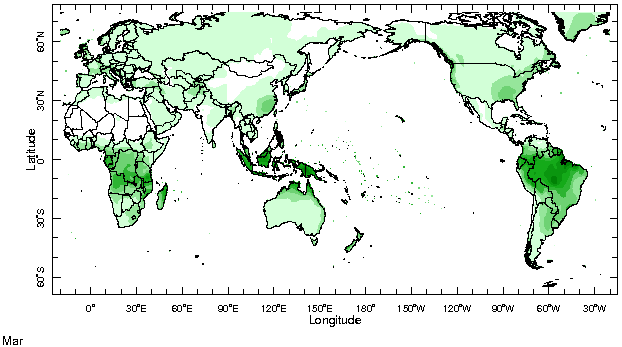|
IRI Climate Digest
April 2006
March Global Climate Summary
Climatological Background
In March, the sun crosses the equator (the Equinox) and begins its migration into the Northern Hemisphere. It is the transition from winter to spring in the Northern Hemisphere, when temperatures begin to increase and storm tracks move northward. In the Southern Hemisphere summer is ending and the monsoon rains are retreating northward.
Monthly Mean Temperature (1961-1990), data from the Climate Research
Unit, University of East Anglia


Monthly Mean Precipitation (1961-1990), data from the Climate Research
Unit, University of East Anglia


Temperatures
Northern Europe experienced unusually cold conditions in March while temperatures across south-central Asia continued to be well above the long-term average, by more than 5°C in central Kazakhstan. The region of higher-than-average temperatures observed across north-central Canada in February moved eastward in March, extending from the northern Plains to the eastern Maritimes. Southern sections of the southern Africa subcontinent were unusually cold in March, while the persistent cool conditions witnessed across coastal Western Australia in recent months eased. Elsewhere, most tropical land areas were near to above average, with temperatures well above average across western Africa and much of northern Mexico.
Temperature Difference from the 1961-1990 mean, with data
from NCEP Climate Prediction Center, CAMS.


Precipitation
Unusually dry conditions across the entire tropical Pacific and above-average rainfall farther west across much of Indonesia, northern Australia, and the Philippines were consistent with weak La Niņa conditions, although the below-average rainfall across eastern Australia was not. Rainfall across Hawaii was well above average, resulting in destructive flooding and landslides. Southern Africa generally saw near- to above-average precipitation as the rainy season draws to a close there. Unusually warm sea surface conditions in the far eastern tropical Pacific were associated with unusually wet conditions across western Peru and Ecuador, with heavy rainfall also experienced in parts of Colombia. Central Europe saw an unusually wet March, and above-average rainfall provided some limited relief to the unusually dry conditions across the south-central US.
Precipitation Difference from 1979-2000 mean, with data
from NCEP Climate Prediction Center, CAMS-OPI.


Oceanic Conditions
The anomalously cool surface conditions in the central equatorial Pacific weakened during March, while above-average sea surface temperatures continued across large portions of the subtropical North and South Pacific. Warmer-than-average conditions across the tropical North Atlantic eased somewhat, though remaining near- to above-average. The tropical Indian Ocean basin had near-average sea surface temperatures for the month. The persistent area of unusually cool waters along the west coast of Australia shifted slightly westward in March, while along Australia's east coast the area of persistent above-average temperatures weakened. Unusually high surface temperatures extended from the Mozambique coast southeastward across the western Indian Ocean. On the west coast of southern Africa, higher-than-average surface temperatures extended from along the Angola coast northward into the far eastern tropical South Atlantic.
Monthly Sea Surface Temperature Difference from the 1971-2000 mean,
with data from the Environmental Modeling Center, NCEP/NOAA.


Contents |
Special |
Impacts |
Climate |
Forecast
|

